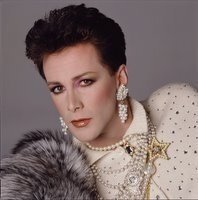Darlings! Mummy has made a decision! After reading dozens of posts and having hundreds of conversations with well-meaning folks who just don't know about the great "character" actors who gave films the depth and genius that surrounded and supported the so-called "stars", I am going to periodically post a regular, special entry called "SYBIL'S WHO'Z DAT?"....there'll be photos and a mini-bio, and the next time you see one of those familiar, fabulous faces that you just "can't quite place", well maybe these posts will help. Some of these actors worked more, had longer and broader careers, and ended up happier, more loved, and even wealthier than the "stars" that the public "worships". (I think there may be a metaphor in that! What do you think???). Here's our next guest!!...and he’s perfect for the October season. What would Halloween be without science fiction, and what would great science fiction films be without John Hoyt (October 5, 1905- September 15, 1991).
Born John McArthur Hoysradt, in Bronxville, New York, he was the son of a banker father who wanted John to follow him in the same profession. His mother, however, countered that wish by promoting the child’s talent for classical piano, and his two sisters worked tirelessly with him, nurturing his vocal techniques. He attended The Hotchkiss School, and later Yale University, where he served on the editorial board of the campus humor magazine “The Yale Record” because of his intelligent wit. He earned both a Bachelor’s and a Master’s degree there and worked as a history instructor at the Groton School in Massachusetts. He appeared at several regional theatres in the 1920s, working as an acting teacher, and even a nightclub comedian as John Hoysradt. He made his Broadway debut in 1930 with the play OVERTURE. Being a very accomplished pianist, he became the “ghost” pianist, playing offstage for Katherine Cornell who was playing a concert pianist in Sidney Howard’s play ALIEN CORN (1932). When Cornell toured 3 plays in repertory the next year, John was invited to play roles in all three. The tour would be a long, arduous trek by train and, as it turned out, John’s roommate on the theatrical odyssey was another newcomer named Orson Welles. He also played in THE ZIEGFELD FOLLIES OF 1936 along with Bob Hope, Josephine Baker, and Fanny Brice. He eventually became an actor with Orson Welles’ Mercury Theatre appearing in Welles’ production of JULIUS CAESAR in 1937 in the role of Decius Brutus (a.k.a. Decimus Junius Brutus Albinus, a role he would play again in film in 1953.)
It was during this time that he married his first wife, Marian Burns, whom the New York Post described as a “former athletics teacher,” and became the father of his only biological child, a son named David. Other productions with Welles included HEARTBREAK HOUSE and ‘TIS PITY SHE’S A WHORE. Continuing his stand-up comedy career, after performances onstage, he would dash off to the Rainbow Room at Rockefeller Center to appear as “The Master Of Satire”. One of his specialties was impressions of famous entertainers, and his impersonation of Noël Coward was so remarkable that he was hired for the original cast of the Broadway comedy THE MAN WHO CAME TO DINNER (1939) in which he played Beverley Carlton. He remained with the Mercury Players until he was called up for military service in 1945. It was not until the age of 40 that he became “Hoyt,” moving the family to Hollywood. Paramount Studios performed the name change and quickly fastened onto Hoyt’s panache with dialects and languages (he spoke five). He made his film debut in O.S.S. (1946), a wartime drama with Alan Ladd about the Office of Strategic Services which was the predecessor to the C.I.A., followed by MY FAVORITE BRUNETTE (1947), a comic take-off on film noir starring Bob Hope, Dorothy Lamour, Peter Lorre, and Lon Chaney Jr.
Among his impressive credits is THE BLACKBOARD JUNGLE (1955) with Glenn Ford and Sidney Poitier. Mr. Hoyt appeared in 75 films, including JULIUS CAESAR (1953) with Marlon Brando, James Mason, and John Gielgud, SPARTACUS (1960) with Kirk Douglas, Charles Laughton, and Lawrence Olivier, and CLEOPATRA (1963) with Elizabeth Taylor, Richard Burton, and Rex Harrison. Because of his classical training, he fit right into these “classical productions" often being mistaken for being British himself.
Although Hoyt played Nazis, indignant fathers, and forbidding megalomaniacs, in his real life, he was tending to his sick wife Marian who, it was known, was suffering from medical problems aggravated by alcoholism. Marian did not survive and John soon after married Dorothy Haverman who had been a close family friend with one son. They were married for his last 25 years. Hoyt’s unusual presence and talent allowed him to participate in science fiction films like THE LOST CONTINENT (1951), WHEN WORLD’S COLLIDE (1951), ATTACK OF THE PUPPET PEOPLE (1958), X: THE MAN WITH THE X-RAY EYES (1963), and several episodes on tv of THE TWILIGHT ZONE, and on the original pilot of STAR TREK in 1964. He was versatile enough to have a huge career in Westerns both in film and on television, and despite his great ability in comedy, the majority of his work existed in gritty dramas, film noir, and mysteries. Over the 1950s and 60s he became a major character guest star on all sorts of television hit programs including THE RIFLEMAN, repeated appearances on PERRY MASON.
In 1982, at age 77, after moving to Santa Cruz, he signed a contract with NBC to play Grandpa Kanisky on NBC’s "Gimme A Break," a role he portrayed for seven years. And in 1985, stock footage of his performance as a man from the future dealing with mutants in THE TIME TRAVELERS (1964) is played in a movie theatre as the final comic sequence in DESPERATELY SEEKING SUSAN (1985) for Madonna and Roseanna Arquette; a wonderful film-within-a-film gimmick! Hoyt died of lung cancer at the age of eighty-five in 1991 in Santa Cruz, California. He was survived by his wife, Dorothy; a son, David, a stepson, Kurt L. Haveman, both of Santa Cruz, and 10 grandchildren. In 1996, Dorothy, in an interview with writer Paul Grondahl, revealed that John had been gay all his life, despite his two marriages. She gushed with love for him. “He was a presence,” she said in a letter. “Whenever he entered, people recognized a special quality of distinction, culture and an engaging manner. John had all the ability to ride easy on the surface of life. He didn’t have to labor over anything. A movie script was presented and memorized immediately. He did not have to strive.” Dorothy, matter of factly indicated they had an agreement and an open marriage and that he was quite open with his young lovers. Hoyt was cremated and his ashes were scattered in the Pacific by his family.
[Want to read other fun and funny stories here on SybilSez.com? Just enter any topic that pops into your head in the "search" window on the upper right! Who knows what might come up?...and feel free to share them with your friends!]

















